Spatial Structure and Corridor Construction of Railway Heritage: A Case Study of the Beijing-Tianjin-Hebei Region
Abstract
1. Introduction
1.1. Trends in the Networked Transformation of Railway Heritage Protection
1.2. The Need for Refined Development in Defining Corridor Widths
1.3. The Regeneration Value and Challenges of Railway Heritage Corridors in the BTH Region
- (1)
- Feature identification: What are the spatial distribution patterns of the railway heritage in the BTH region? Do discernible heritage clusters exist?
- (2)
- Mechanism analysis: How do environmental factors, including human and natural components, affect suitability zoning for railway heritage corridor development in the BTH region? Is spatial continuity present in areas deemed suitable for construction?
- (3)
- Methodological innovation: How can optimal routes and rational spatial extents of railway heritage corridors in the BTH region be scientifically established? Based on these findings, what differentiated regional collaborative conservation strategies can be proposed to address diverse protection and development objectives, thereby offering decision-making support for the effective conservation and rational utilization of railway heritage?
2. Materials and Methods
2.1. Research Area
2.2. Data Sources
2.3. Research Methods
2.4. Spatial Clustering of Heritage Sites
2.5. Construction of Comprehensive Resistance Surface
2.5.1. MCR Model
2.5.2. Optimal Parameter-Based Geographical Detectors
2.6. Calculation of Functional Connectivity
3. Results
3.1. Distribution of Railway Heritage Sources
3.2. Spatial Patterns of Comprehensive Resistance Surface
3.3. Construction of Railway Heritage Corridors Based on Suitability Analysis
4. Discussion
4.1. Optimization of the Route Planning Method for Railway Heritage Corridors
4.2. Methodological Advancement in Delineating Spatial Extent of Railway Heritage Corridors
4.3. Guidance on the Construction of Railway Heritage Corridors in Metropolitan Areas
4.3.1. Spatial Coupling: Topological Overlay of Railway Network and Heritage Corridors
4.3.2. Functional Iteration: Activation of Cultural and Tourism Functions at Heritage Sites
4.3.3. Collaborative Management: Cross-Regional Railway Heritage Governance System
4.4. International Transferability and Limitations
5. Conclusions
Supplementary Materials
Author Contributions
Funding
Data Availability Statement
Conflicts of Interest
References
- Martí-Henneberg, J. The Influence of the Railway Network on Territorial Integration in Europe (1870–1950). J. Transp. Geogr. 2017, 62, 160–171. [Google Scholar] [CrossRef]
- Pietrzak, K.; Pietrzak, O.; Montwiłł, A. Light Freight Railway (LFR) as an Innovative Solution for Sustainable Urban Freight Transport. Sustain. Cities Soc. 2021, 66, 102663. [Google Scholar] [CrossRef]
- Li, X.; Xia, H. Evaluation of the regeneration value of a railway heritage corridor: A case study based on Beijing-Zhangjiakou railway (Beijing section). South Archit. 2023, 3, 40–51. [Google Scholar] [CrossRef]
- Ferretti, V.; Degioanni, A. How to Support the Design and Evaluation of Redevelopment Projects for Disused Railways? A Methodological Proposal and Key Lessons Learned. Transp. Res. Part Transp. Environ. 2017, 52, 29–48. [Google Scholar] [CrossRef]
- Taylor, T.; Landorf, C. Subject–Object Perceptions of Heritage: A Framework for the Study of Contrasting Railway Heritage Regeneration Strategies. Int. J. Herit. Stud. 2015, 21, 1050–1067. [Google Scholar] [CrossRef]
- USA Rails-To-Trails Conservancy (RTC) Website. Available online: https://www.railstotrails.org/about/ (accessed on 8 October 2025).
- European Greenways Association (AEVV-EGWA) Website. Available online: https://www.aevv-egwa.org/ (accessed on 8 October 2025).
- UK Heritage Railway Association (HRA) Website. Available online: https://www.hra.uk.com/ (accessed on 12 October 2025).
- Scherrer, P.; Dimmock, K.; Lamont, M.; Ripoll González, L. Rail Trails Literature: Current Status and Future Research. J. Leis. Res. 2021, 52, 97–119. [Google Scholar] [CrossRef]
- Bhati, A.; Pryce, J.; Chaiechi, T. Industrial Railway Heritage Trains: The Evolution of a Heritage Tourism Genre and Its Attributes. J. Herit. Tour. 2014, 9, 114–133. [Google Scholar] [CrossRef]
- Ruiz, R.; Rodríguez, J.; Coronado, J.M. Modern Roads as UNESCO World Heritage Sites: Framework and Proposals. Int. J. Herit. Stud. 2017, 23, 362–374. [Google Scholar] [CrossRef]
- Oliveira, E.R.D.; Silva, M.M.; Deus, J.D.; Santana Junior, E.; Costa, A.; Lara, A.P.; Santos, B.; Berata, T.; Bueno, V. Social Valuation of Protected Cultural Assets: The Railway Heritage between Jundiaí and Campinas (Brazil). Int. J. Herit. Stud. 2022, 28, 714–732. [Google Scholar] [CrossRef]
- Eizaguirre-Iribar, A.; Grijalba, O.; Hernández-Minguillón, R.J. An Integrated Approach to Transportation and Land-Use Planning for the Analysis of Former Railway Nodes in Sustainable Transport Development: The Case of the Vasco-Navarro Railway. Sustainability 2021, 13, 322. [Google Scholar] [CrossRef]
- Della Spina, L.; Lanteri, C. A Collaborative Multi-Criteria Decision-Making Framework for the Adaptive Reuse Design of Disused Railways. Land 2024, 13, 851. [Google Scholar] [CrossRef]
- Bianchi, A.; De Medici, S. A Sustainable Adaptive Reuse Management Model for Disused Railway Cultural Heritage to Boost Local and Regional Competitiveness. Sustainability 2023, 15, 5127. [Google Scholar] [CrossRef]
- Liu, F.; Lu, Z.; Qiang, W. An Innovative Approach to Post-Occupancy Evaluation of Architectural Heritages in the Peking-Mukden Railway. Herit. Sci. 2024, 12, 383. [Google Scholar] [CrossRef]
- Modesto, A.; Kamenečki, M.; Tomić Reljić, D. Application of Suitability Modeling in Establishing a New Bicycle–Pedestrian Path: The Case of the Abandoned Kanfanar–Rovinj Railway in Istria. Land 2021, 10, 600. [Google Scholar] [CrossRef]
- Rovelli, R.; Senes, G.; Fumagalli, N.; Sacco, J.; De Montis, A. From Railways to Greenways: A Complex Index for Supporting Policymaking and Planning. A Case Study in Piedmont (Italy). Land Use Policy 2020, 99, 104835. [Google Scholar] [CrossRef]
- Eizaguirre-Iribar, A.; Grijalba, O. A Methodological Proposal for the Analysis of Disused Railway Lines as Territorial Structuring Elements: The Case Study of the Vasco-Navarro Railway. Land Use Policy 2020, 91, 104406. [Google Scholar] [CrossRef]
- Mısırlısoy, D.; Günçe, K. Railways as Common Cultural Heritage: Cyprus Government Railway. Hist. Environ. Policy Pract. 2023, 14, 112–128. [Google Scholar] [CrossRef]
- Jurković, Ž.; Hadzima-Nyarko, M.; Lovoković, D. Railway Corridors in Croatian Cities as Factors of Sustainable Spatial and Cultural Development. Sustainability 2021, 13, 6928. [Google Scholar] [CrossRef]
- Zhang, Z.; Cao, R.; Kang, F. Spatial and temporal distribution characteristics of the industrial heritage along the Taiyuan-Baijiazhuang railway and analysis of the suitability construction of heritage corridors. J. Arid Land Resour. Environ. 2024, 38, 40–51. [Google Scholar] [CrossRef]
- Wang, C.; Ma, Q. Study on the Construction of the Beijing-Tianjin-Hebei Railway Heritage Corridor. J. Cap. Norm. Univ. Sci. Ed. 2017, 3, 71–78. [Google Scholar] [CrossRef]
- Conzen, M.P.; Wulfestieg, B.M. Metropolitan Chicago’s Regional Cultural Park: Assessing the Development of the Illinois & Michigan Canal National Heritage Corridor. J. Geogr. 2001, 100, 111–117. [Google Scholar] [CrossRef]
- Wang, Q.; Yang, C.; Wang, J.; Tan, L. Tourism in Historic Urban Areas: Construction of Cultural Heritage Corridor Based on Minimum Cumulative Resistance and Gravity Model—A Case Study of Tianjin, China. Buildings 2024, 14, 2144. [Google Scholar] [CrossRef]
- Li, H.; Zhang, T.; Cao, X.; Yao, L. Active Utilization of Linear Cultural Heritage Based on Regional Ecological Security Pattern along the Straight Road (Zhidao) of the Qin Dynasty in Shaanxi Province, China. Land 2023, 12, 1361. [Google Scholar] [CrossRef]
- Lin, F.; Zhang, X.; Ma, Z.; Zhang, Y. Spatial Structure and Corridor Construction of Intangible Cultural Heritage: A Case Study of the Ming Great Wall. Land 2022, 11, 1478. [Google Scholar] [CrossRef]
- Zhou, G.; Huan, Y.; Wang, L.; Lan, Y.; Liang, T.; Shi, B.; Zhang, Q. Linking Ecosystem Services and Circuit Theory to Identify Priority Conservation and Restoration Areas from an Ecological Network Perspective. Sci. Total Environ. 2023, 873, 162261. [Google Scholar] [CrossRef]
- Peng, J.; Yang, Y.; Liu, Y.; Hu, Y.; Du, Y.; Meersmans, J.; Qiu, S. Linking Ecosystem Services and Circuit Theory to Identify Ecological Security Patterns. Sci. Total Environ. 2018, 644, 781–790. [Google Scholar] [CrossRef] [PubMed]
- Kang, J.; Li, C.; Li, M.; Zhang, T.; Zhang, B. Identifying Priority Areas for Conservation in the Lower Yellow River Basin from an Ecological Network Perspective. Ecosyst. Health Sustain. 2022, 8, 2105751. [Google Scholar] [CrossRef]
- Van Schalkwyk, J.; Pryke, J.S.; Samways, M.J.; Gaigher, R. Corridor Width Determines Strength of Edge Influence on Arthropods in Conservation Corridors. Landsc. Ecol. 2020, 35, 1175–1185. [Google Scholar] [CrossRef]
- Li, X.; Zhu, R.; Shi, C.; Yang, X.; Chen, J.; Wei, K. Research on the Construction of Intangible Cultural Heritage Corridors in the Yellow River Basin Based on Geographic Information System (GIS) Technology and the Minimum Cumulative Resistance (MCR) Model. Herit. Sci. 2024, 12, 271. [Google Scholar] [CrossRef]
- Wu, J.; Li, C.; Wang, T. Optimizing Landscape Patterns for Tea Plantation Agroecosystems: A Case Study of an Important Agricultural Heritage System in Enshi, China. Land 2025, 14, 1491. [Google Scholar] [CrossRef]
- Lin, Z.; Li, B. Circuit Theory-Based Cultural Heritage Corridor Network Development in Qin River Basin. Npj Herit. Sci. 2025, 13, 385. [Google Scholar] [CrossRef]
- McRae, B.H.; Dickson, B.G.; Keitt, T.H.; Shah, V.B. Using Circuit Theory to Model Connectivity in Ecology, Evolution, and Conservation. Ecology 2008, 89, 2712–2724. [Google Scholar] [CrossRef] [PubMed]
- McRae, B.H.; Beier, P. Circuit Theory Predicts Gene Flow in Plant and Animal Populations. Proc. Natl. Acad. Sci. USA 2007, 104, 19885–19890. [Google Scholar] [CrossRef] [PubMed]
- Baguette, M.; Blanchet, S.; Legrand, D.; Stevens, V.M.; Turlure, C. Individual Dispersal, Landscape Connectivity and Ecological Networks. Biol. Rev. 2013, 88, 310–326. [Google Scholar] [CrossRef] [PubMed]
- Willemen, L.; Hein, L.; Van Mensvoort, M.E.F.; Verburg, P.H. Space for People, Plants, and Livestock? Quantifying Interactions among Multiple Landscape Functions in a Dutch Rural Region. Ecol. Indic. 2010, 10, 62–73. [Google Scholar] [CrossRef]
- Huang, L.; Chen, Z.; Yang, Z.; Chen, M.; Chen, X.; Zhai, T.; Qiu, T. Integrating “Quality-Risk-Demand” Framework and Circuit Theory to Identify Spatial Range and Priority Area of Ecological Security Pattern in a Rapidly Urbanizing Landscape. Ecol. Inform. 2024, 82, 102673. [Google Scholar] [CrossRef]
- Koen, E.L.; Garroway, C.J.; Wilson, P.J.; Bowman, J. The Effect of Map Boundary on Estimates of Landscape Resistance to Animal Movement. PLoS ONE 2010, 5, e11785. [Google Scholar] [CrossRef]
- Su, J.; Kong, F.; Yin, H.; Meadows, M.; Zhou, K.; Li, Z.; Cui, H. Past, Present and Future Climate Connectivity Informs Conservation Strategies in the Yangtze River Delta Urban Agglomeration, China. Landsc. Urban Plan. 2023, 240, 104894. [Google Scholar] [CrossRef]
- Yang, J.; Dong, J.; Xiao, X.; Dai, J.; Wu, C.; Xia, J.; Zhao, G.; Zhao, M.; Li, Z.; Zhang, Y.; et al. Divergent Shifts in Peak Photosynthesis Timing of Temperate and Alpine Grasslands in China. Remote Sens. Environ. 2019, 233, 111395. [Google Scholar] [CrossRef]
- Feng, Y.; Wei, H.; Huang, Y.; Li, J.; Mu, Z.; Kong, D. Spatiotemporal Evolution Characteristics and Influencing Factors of Traditional Villages: The Yellow River Basin in Henan Province, China. Herit. Sci. 2023, 11, 97. [Google Scholar] [CrossRef]
- Ester, M.; Kriegel, H.-P.; Sander, J.; Xu, X. A Density-Based Algorithm for Discovering Clusters in Large Spatial Databases with Noise. In Proceedings of the Second International Conference on Knowledge Discovery and Data Mining, Portland, OR, USA, 2–4 August 1996; AAAI Press: Portland, OR, USA, 1996; pp. 226–231. [Google Scholar]
- Sun, Y.; Wang, Y.; Liu, L.; Wei, Z.; Li, J.; Cheng, X. Large-Scale Cultural Heritage Conservation and Utilization Based on Cultural Ecology Corridors: A Case Study of the Dongjiang-Hanjiang River Basin in Guangdong, China. Herit. Sci. 2024, 12, 44. [Google Scholar] [CrossRef]
- Fan, X.; Wang, Z.; Li, S. Value Evaluation Model (VEM) of Ancient Chinese Military Settlement Heritage: A Case Study of Liaoxi Corridor in the Ming Dynasty. Herit. Sci. 2024, 12, 97. [Google Scholar] [CrossRef]
- Knaapen, J.P.; Scheffer, M.; Harms, B. Estimating Habitat Isolation in Landscape Planning. Landsc. Urban Plan. 1992, 23, 1–16. [Google Scholar] [CrossRef]
- Xu, L.; Zhang, Z.; Tan, G.; Yuan, L. Research on the Reuse Path of the Third Front Construction Stock Space in China Based on Value Assessment. Front. Archit. Res. 2025, 14, 77–93. [Google Scholar] [CrossRef]
- Wang, J.-F.; Zhang, T.-L.; Fu, B.-J. A Measure of Spatial Stratified Heterogeneity. Ecol. Indic. 2016, 67, 250–256. [Google Scholar] [CrossRef]
- Wang, J.; Li, X.; Christakos, G.; Liao, Y.; Zhang, T.; Gu, X.; Zheng, X. Geographical Detectors--based Health Risk Assessment and Its Application in the Neural Tube Defects Study of the Heshun Region, China. Int. J. Geogr. Inf. Sci. 2010, 24, 107–127. [Google Scholar] [CrossRef]
- Song, Y.; Wang, J.; Ge, Y.; Xu, C. An Optimal Parameters-Based Geographical Detector Model Enhances Geographic Characteristics of Explanatory Variables for Spatial Heterogeneity Analysis: Cases with Different Types of Spatial Data. GIScience Remote Sens. 2020, 57, 593–610. [Google Scholar] [CrossRef]
- Huang, L.; Wang, J.; Fang, Y.; Zhai, T.; Cheng, H. An Integrated Approach towards Spatial Identification of Restored and Conserved Priority Areas of Ecological Network for Implementation Planning in Metropolitan Region. Sustain. Cities Soc. 2021, 69, 102865. [Google Scholar] [CrossRef]
- Weber, T.; Norman, J. Functional Connectivity Modeling and Optimal Siting of Conservation Networks in the Midwest USA. Ecol. Inform. 2015, 30, 277–283. [Google Scholar] [CrossRef]
- Yu, H.; Xiao, H.; Gu, X. Integrating Species Distribution and Piecewise Linear Regression Model to Identify Functional Connectivity Thresholds to Delimit Urban Ecological Corridors. Comput. Environ. Urban Syst. 2024, 113, 102177. [Google Scholar] [CrossRef]
- Zhang, L.; Yu, H.; Zhong, Q.; Zhang, G.; Zhang, Q. Research on the Spatial Demarcation of Urban Ecological Corridors Based on Functional Connectivity. Chin. Landsc. Archit. 2024, 40, 6–14. [Google Scholar] [CrossRef]
- Dong, J.; Peng, J.; Xu, Z.; Liu, Y.; Wang, X.; Li, B. Integrating Regional and Interregional Approaches to Identify Ecological Security Patterns. Landsc. Ecol. 2021, 36, 2151–2164. [Google Scholar] [CrossRef]
- Yin, Y.; Liu, S.; Sun, Y.; Zhao, S.; An, Y.; Dong, S.; Coxixo, A. Identifying Multispecies Dispersal Corridor Priorities Based on Circuit Theory: A Case Study in Xishuangbanna, Southwest China. J. Geogr. Sci. 2019, 29, 1228–1245. [Google Scholar] [CrossRef]
- Sun, D.; Wu, X.; Wen, H.; Ma, X.; Zhang, F.; Ji, Q.; Zhang, J. Ecological Security Pattern Based on XGBoost-MCR Model: A Case Study of the Three Gorges Reservoir Region. J. Clean. Prod. 2024, 470, 143252. [Google Scholar] [CrossRef]
- Du, C.; Pan, D.; Liu, Q. The Construction of a Protection Network for Traditional Settlements across Regions: A Case Study of the Chengdu–Chongqing Ancient Post Road Heritage Corridor in China. Land 2025, 14, 327. [Google Scholar] [CrossRef]
- Ge, Y.; Liu, Y.; Ma, Y.; Wang, Y.; Guo, Y.; He, J.; Mao, Y. Spatial Identification and Corridor Network Analysis of Cultural Heritage Based on Multi-Model Fusion: A Case Study of Western Henan. Ecol. Indic. 2025, 178, 113859. [Google Scholar] [CrossRef]
- Yu, H.; Chen, Q.; Hu, X. Tourist interest areas and spatial movement patterns on the Qinghai-Tibet plateau based on dynamic trajectory similarity. Habitat Int. 2025, 163, 103500. [Google Scholar] [CrossRef]
- Tian, Z.; Wang, Q.; Liu, Y.; Wang, Z. Comparison of the tourist mobility patterns among demographic subgroups with mobile phone data: A case study of Chongqing, China. Appl. Geogr. 2023, 159, 103090. [Google Scholar] [CrossRef]
- Cao, L.; Wang, K.; Zhao, X.; Zhang, Y. Optimizing Composite Ecological Networks through Synergistic Risk Management, Ecological Conservation, and Recreational Integration: A Case Study of Beijing’s Shallow Mountain Regions. Ecol. Indic. 2025, 170, 113026. [Google Scholar] [CrossRef]
- Wang, Y.; Qu, Z.; Zhong, Q.; Zhang, Q.; Zhang, L.; Zhang, R.; Yi, Y.; Zhang, G.; Li, X.; Liu, J. Delimitation of Ecological Corridors in a Highly Urbanizing Region Based on Circuit Theory and MSPA. Ecol. Indic. 2022, 142, 109258. [Google Scholar] [CrossRef]
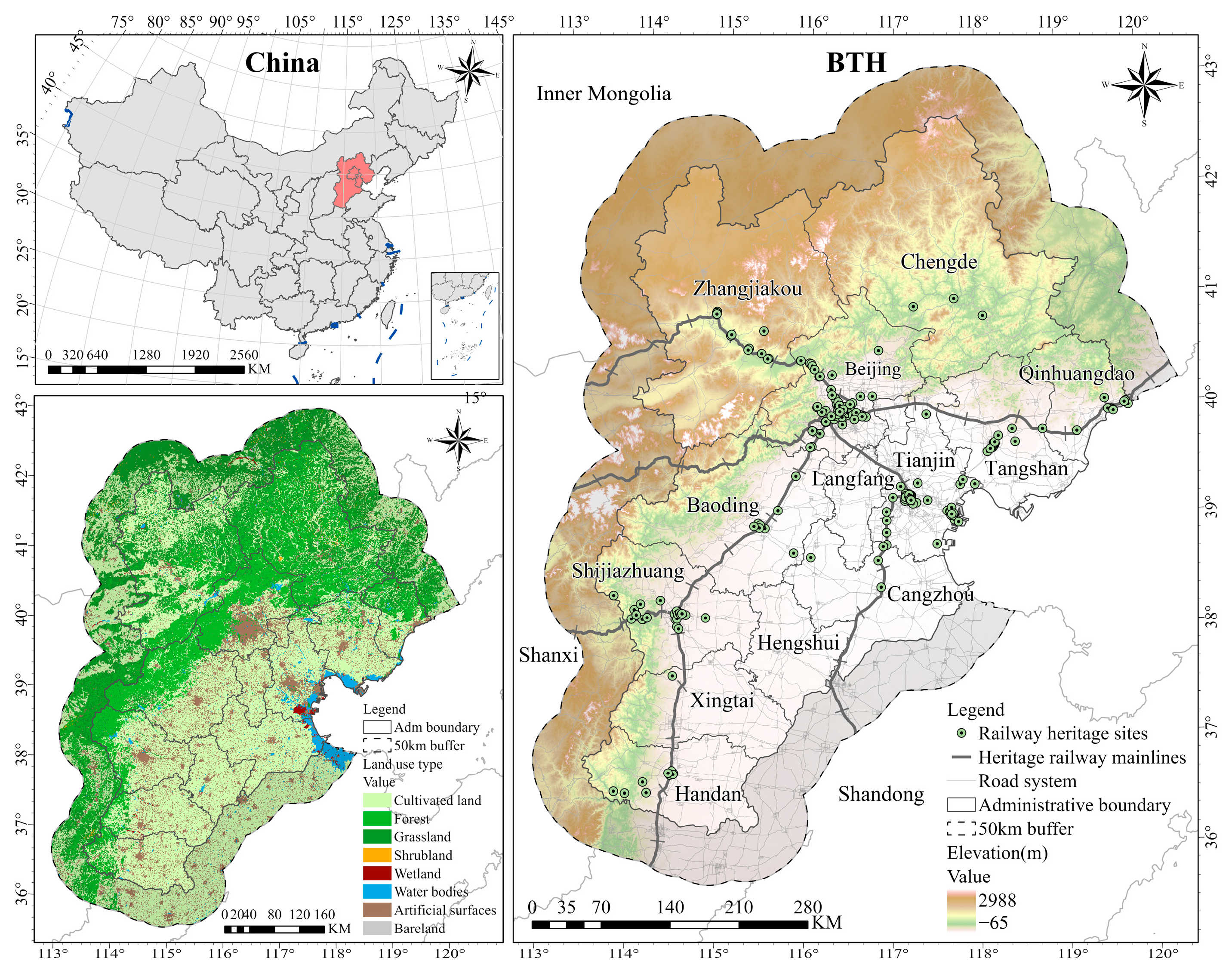
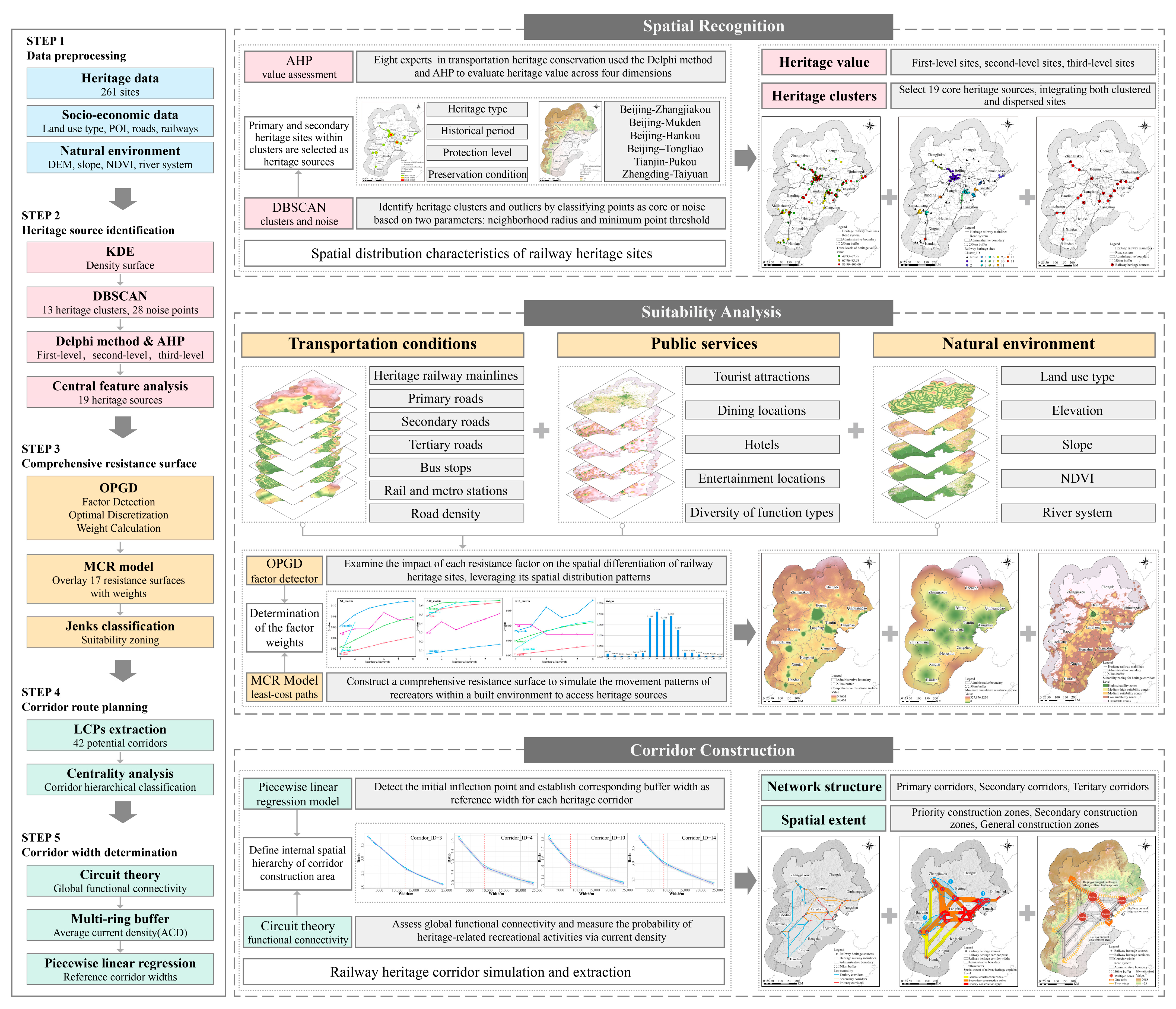
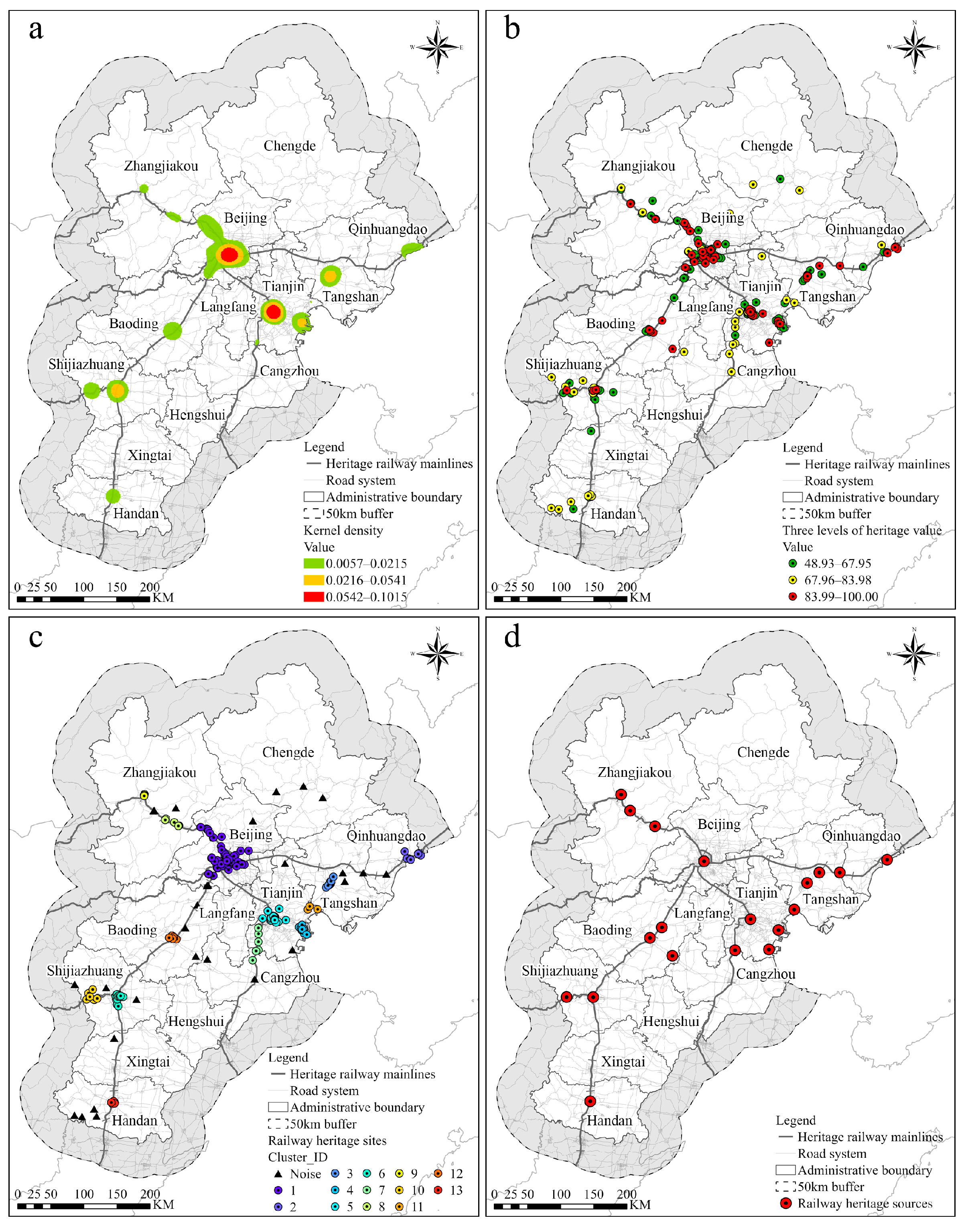
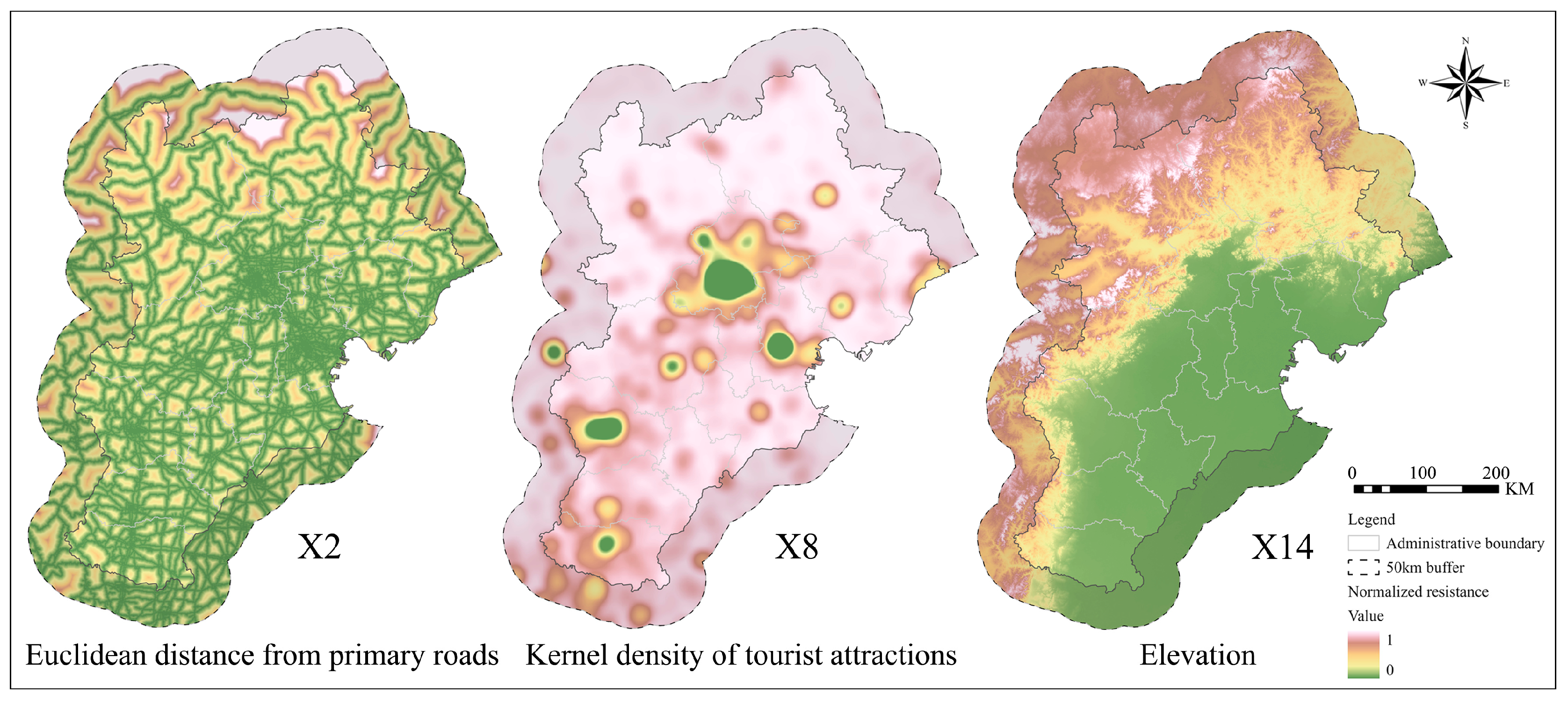
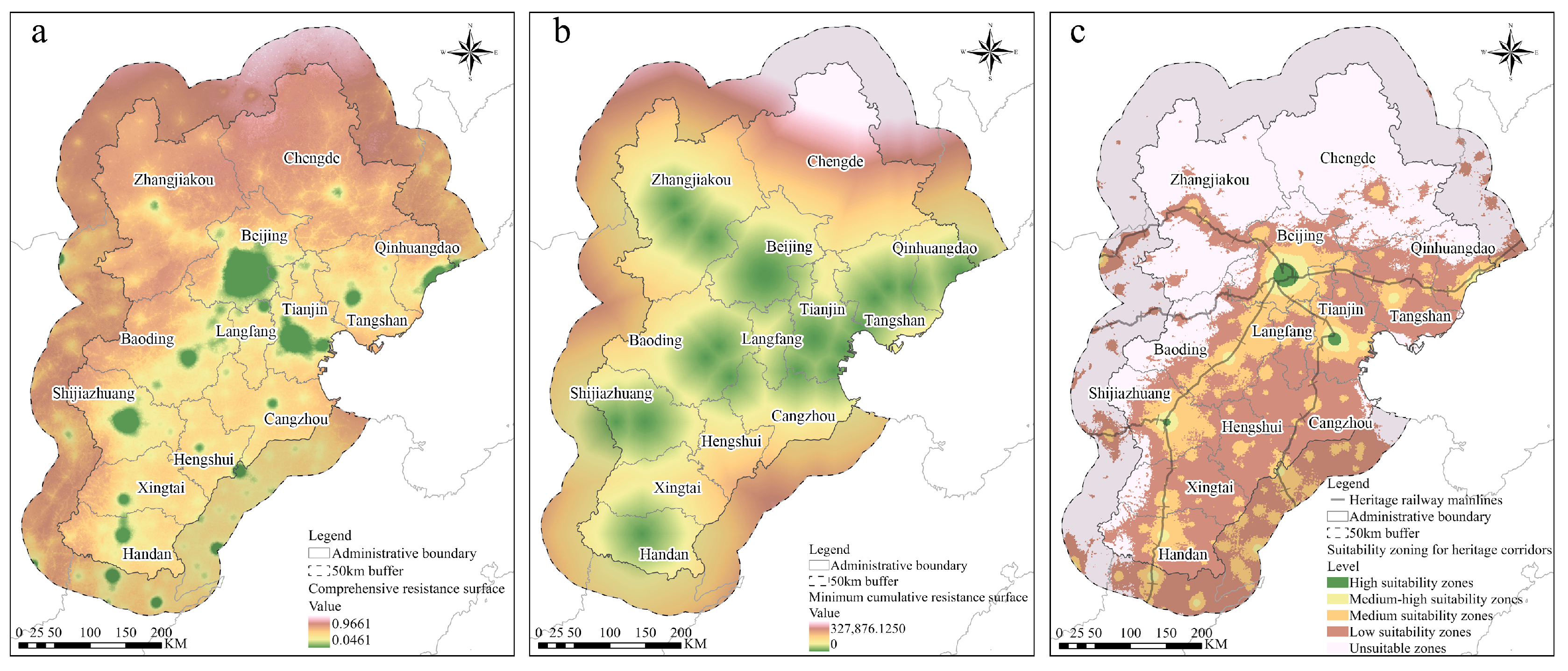
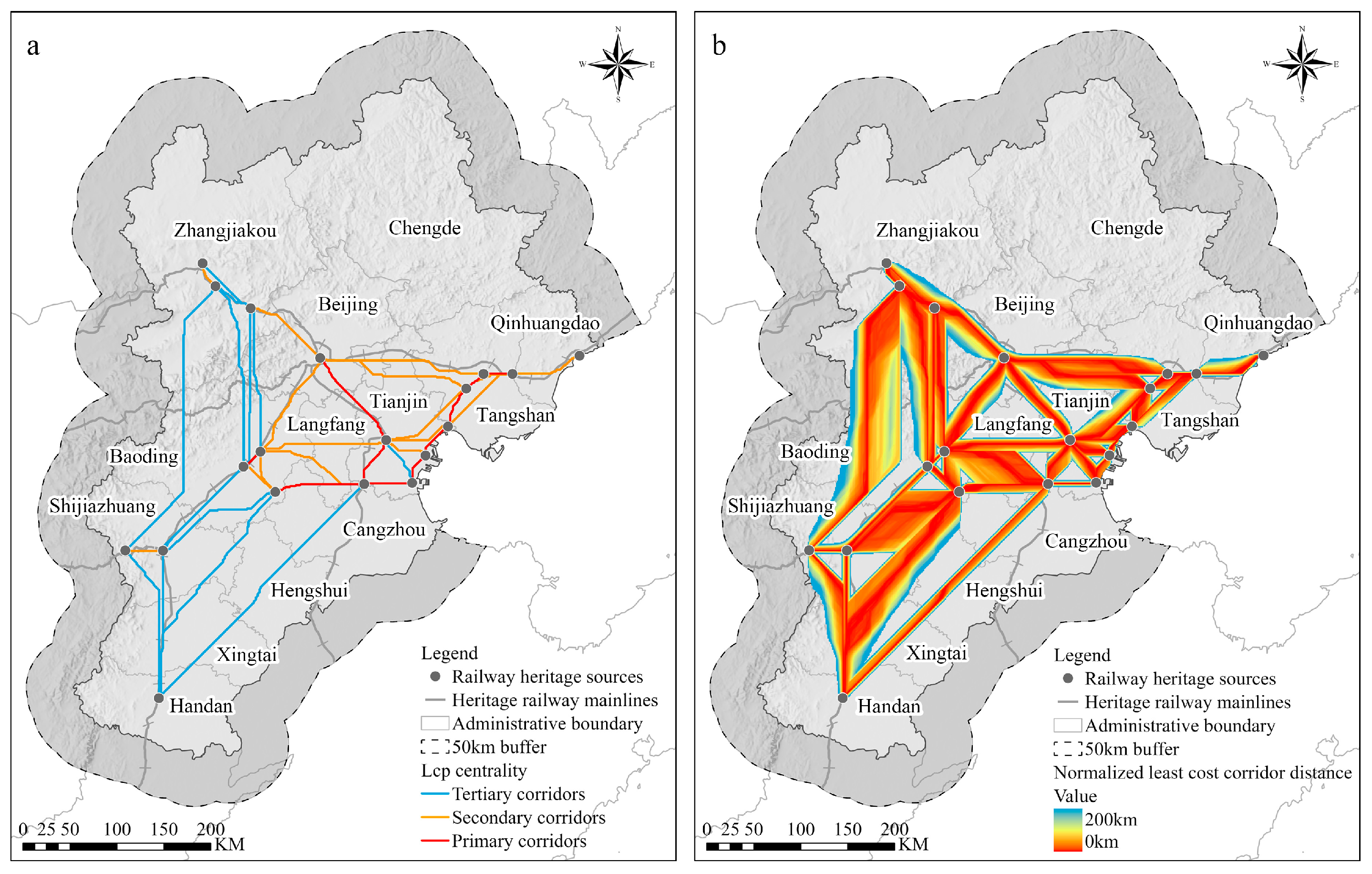
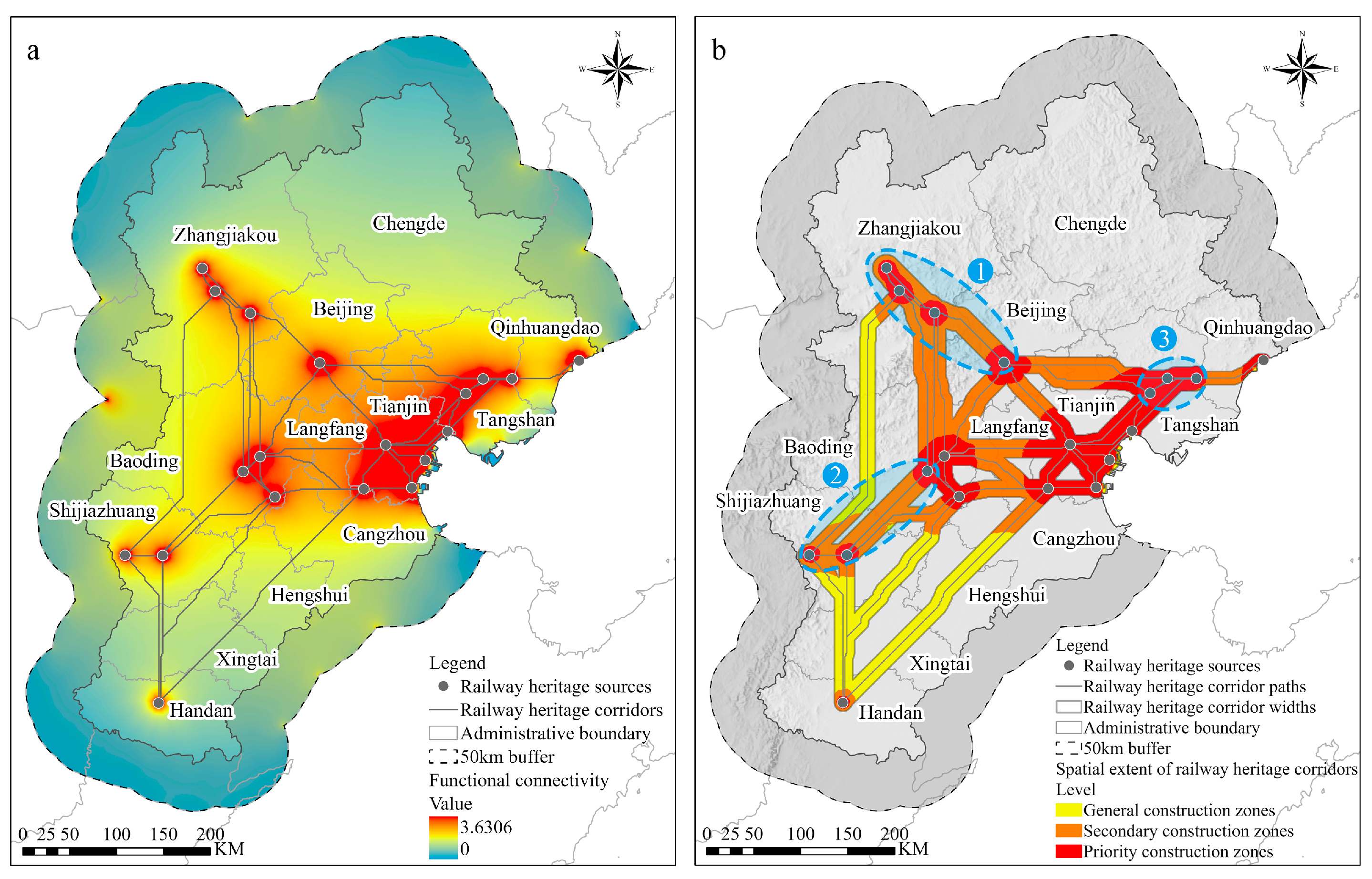
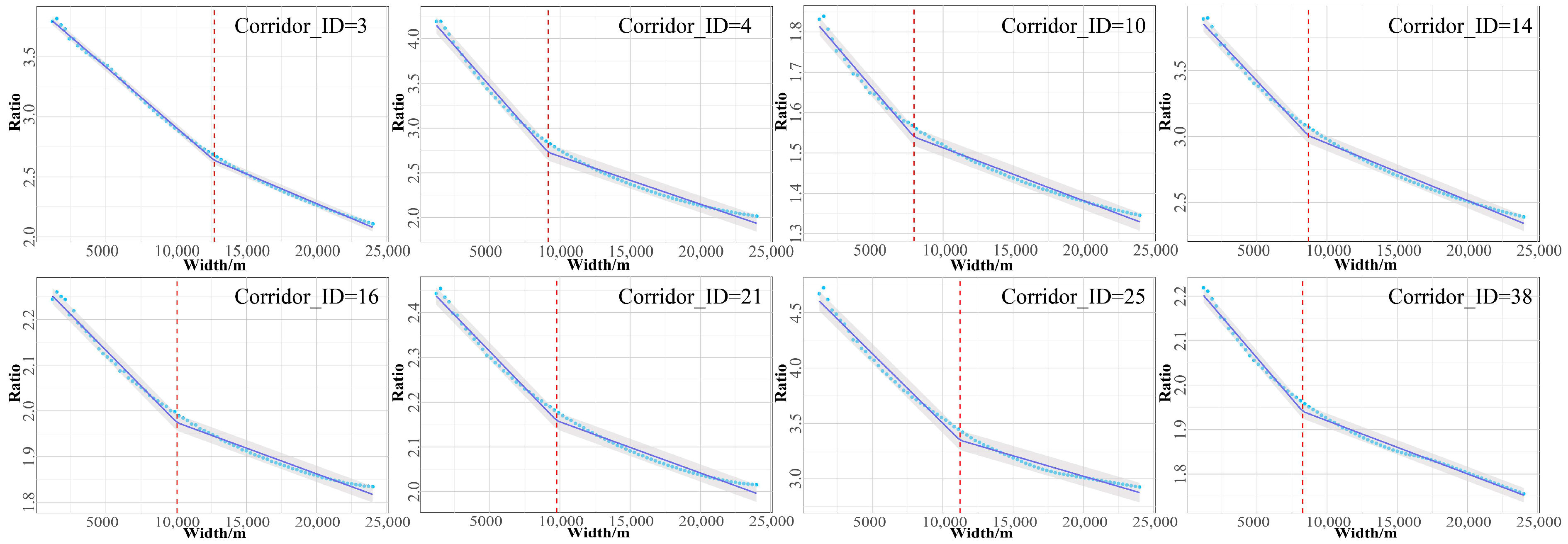
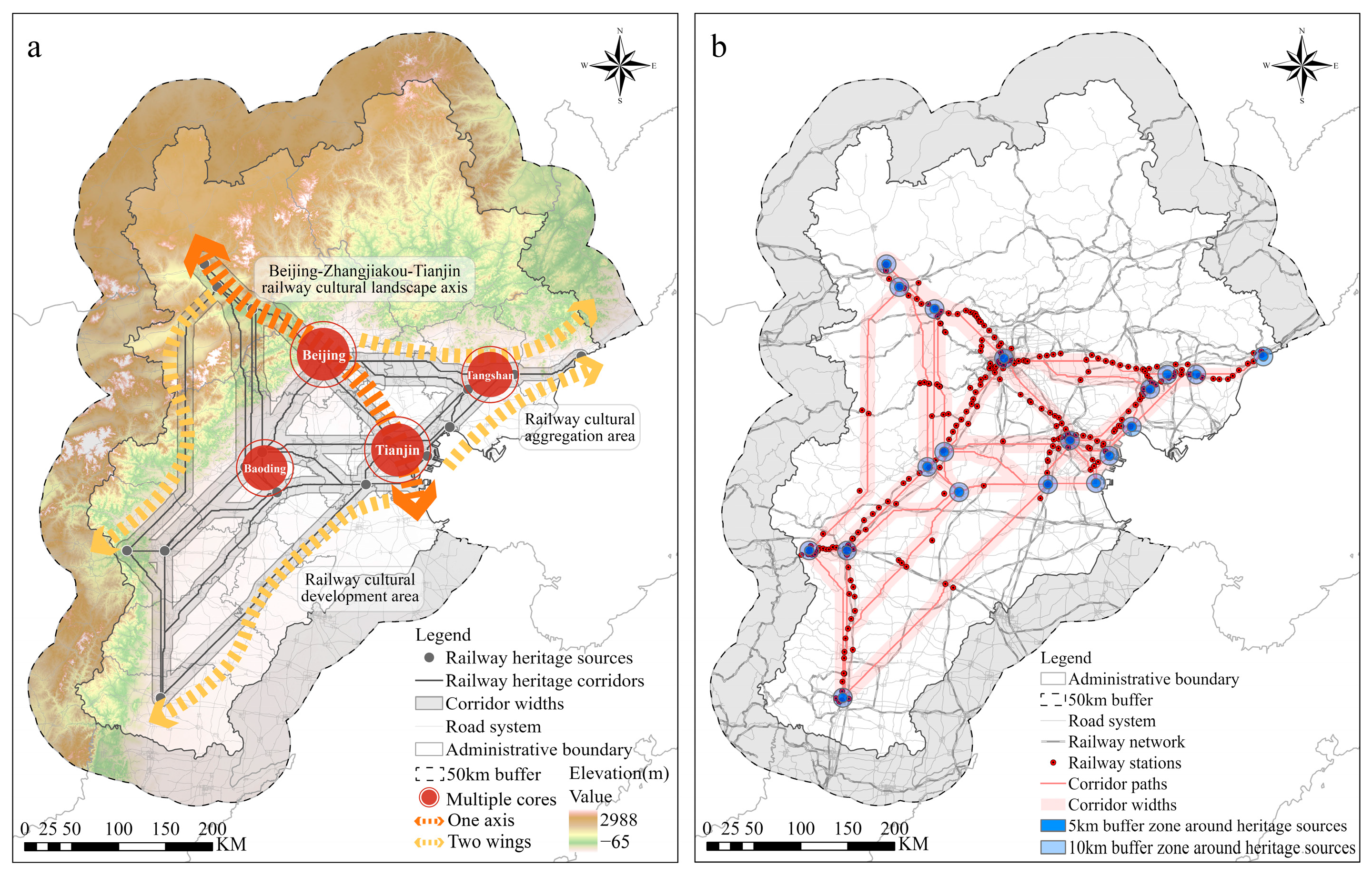
| No. | Type | Data | Description | Source |
|---|---|---|---|---|
| 1 | Heritage data | Railway heritage sites | Vector data | This study conducted screening and compilation based on industrial heritage inventories published by government departments or research institutions including five national, provincial, and municipal heritage lists (see Table S1 in the Supplementary Materials for detailed URLs). Additionally, the author supplements the data with findings from field investigations, resulting in an integrated railway heritage list for the BTH region, comprising 261 sites. The corresponding geographic coordinates were obtained from Tianditu. |
| 2 | Socio-economic data | Administrative boundaries | Vector data | National Geomatics Center of China, Tianditu (https://cloudcenter.tianditu.gov.cn/administrativeDivision/, accessed on 12 October 2025) |
| 3 | Land use type | Raster (30 × 30 m) | National Geomatics Center of China, GlobeLand30 (https://www.webmap.cn/mapDataAction.do?method=globalLandCover, accessed on 12 October 2025) | |
| 4 | Point of interest (POI) | Vector data | Amap open platform (https://lbs.amap.com/, accessed on 12 October 2025) | |
| 5 | Public transport system | Vector data | Amap open platform (https://lbs.amap.com/, accessed on 12 October 2025) | |
| 6 | Road system | Vector data | Resource and Environment Data Cloud Platform (https://www.resdc.cn/data.aspx?DATAID=237, accessed on 12 October 2025) | |
| 7 | Natural environment data | Digital evaluation model (DEM) | Raster (30 × 30 m) | Resource and Environment Data Cloud Platform (https://www.resdc.cn/data.aspx?DATAID=217, accessed on 12 October 2025) |
| 8 | Slope | Raster (30 × 30 m) | From the processing of DEM data | |
| 9 | River system | Vector data | Resource and Environment Data Cloud Platform (https://www.resdc.cn/DOI/DOI.aspx?DOIid=44, accessed on 12 October 2025) | |
| 10 | Normalized difference vegetation index (NDVI) | Raster (30 × 30 m) | Jilin Yang et al. (https://doi.org/10.1016/j.rse.2019.111395, accessed on 12 October 2025) [42] |
| Factor | Analysis | Classification Index | Value | Weight |
|---|---|---|---|---|
| Heritage type | Elucidate the functional attributes of heritage sites and their extent of linkage to the developmental trajectory of railway systems | Architectural heritage directly linked to railway systems including station buildings, water towers, and locomotive depots | 100 | 0.1259 |
| Mining, metallurgical, and port-related heritage instrumental in shaping the evolution of railway systems | 80 | |||
| Additional industrial heritage indirectly connected to railway development | 60 | |||
| Historical period | Articulate the historical significance of the heritage, wherein greater antiquity correlates with heightened historical importance | Constructed before the 1930s | 100 | 0.0727 |
| Constructed between the 1940s and 1960s | 80 | |||
| Constructed after the 1970s | 60 | |||
| Protection level | Depict the comprehensive value and societal influence of the heritage, drawing on evaluation outcomes from government agencies or research institutions | Included in the national heritage lists | 100 | 0.5538 |
| Included in the provincial or directly administered municipal heritage lists | 80 | |||
| Included in the general city or county-level heritage lists | 60 | |||
| Undesignated heritage sites, indicating a lower level of protection or value yet to be confirmed | 40 | |||
| Preservation condition | Reveal the extent of preservation integrity of the heritage and its stage of cultural tourism advancement | Well-preserved with a high level of reuse potential | 100 | 0.2477 |
| Moderately preserved with an average level of reuse potential | 80 | |||
| Poorly preserved with a low level of reuse potential | 60 |
| Dimension | Indicator | Discmethod | Discitv | q Value | Weight |
|---|---|---|---|---|---|
| Transportation conditions | X1: Euclidean distance from the heritage railway mainlines | Quantile | 8 | 0.0502 | 0.0150 |
| X2: Euclidean distance from primary roads | Geometric | 4 | 0.0199 | 0.0059 | |
| X3: Euclidean distance from secondary roads | Geometric | 4 | 0.0115 | 0.0034 | |
| X4: Euclidean distance from tertiary roads | Quantile | 7 | 0.0076 | 0.0023 | |
| X5: Euclidean distance from bus stops | Geometric | 4 | 0.0404 | 0.0120 | |
| X6: Euclidean distance from rail and metro stations | Geometric | 4 | 0.0549 | 0.0164 | |
| X7: Road density | Equal | 8 | 0.6049 | 0.1806 | |
| Public services | X8: Kernel density of tourist attractions (including A-level and higher scenic areas, national key cultural relic protection units, and historical and cultural cities, towns, and villages within BTH) | Natural | 8 | 0.7083 | 0.2114 |
| X9: Kernel density of dining locations | Natural | 8 | 0.5842 | 0.1744 | |
| X10: Kernel density of hotels | Natural | 8 | 0.6397 | 0.1910 | |
| X11: Kernel density of entertainment locations | Natural | 8 | 0.4252 | 0.1269 | |
| X12: Diversity of function types (Shannon diversity index), , is the proportion of the i-th type of POI, and is the total number of POI types. | Equal | 8 | 0.0656 | 0.0196 | |
| Natural environment | X13: Land use type | Cultivated land, forest, grassland, shrubland, wetland, water bodies, artificial surfaces, bareland | 8 | 0.0647 | 0.0193 |
| X14: Elevation | Geometric | 7 | 0.0351 | 0.0105 | |
| X15: Slope | Quantile | 8 | 0.0161 | 0.0048 | |
| X16: Vegetation coverage (NDVI) | Geometric | 8 | 0.0157 | 0.0047 | |
| X17: Euclidean distance from rivers | Quantile | 7 | 0.0058 | 0.0017 |
Disclaimer/Publisher’s Note: The statements, opinions and data contained in all publications are solely those of the individual author(s) and contributor(s) and not of MDPI and/or the editor(s). MDPI and/or the editor(s) disclaim responsibility for any injury to people or property resulting from any ideas, methods, instructions or products referred to in the content. |
© 2025 by the authors. Licensee MDPI, Basel, Switzerland. This article is an open access article distributed under the terms and conditions of the Creative Commons Attribution (CC BY) license (https://creativecommons.org/licenses/by/4.0/).
Share and Cite
Li, X.; Xia, H. Spatial Structure and Corridor Construction of Railway Heritage: A Case Study of the Beijing-Tianjin-Hebei Region. Land 2025, 14, 2139. https://doi.org/10.3390/land14112139
Li X, Xia H. Spatial Structure and Corridor Construction of Railway Heritage: A Case Study of the Beijing-Tianjin-Hebei Region. Land. 2025; 14(11):2139. https://doi.org/10.3390/land14112139
Chicago/Turabian StyleLi, Xinyi, and Haishan Xia. 2025. "Spatial Structure and Corridor Construction of Railway Heritage: A Case Study of the Beijing-Tianjin-Hebei Region" Land 14, no. 11: 2139. https://doi.org/10.3390/land14112139
APA StyleLi, X., & Xia, H. (2025). Spatial Structure and Corridor Construction of Railway Heritage: A Case Study of the Beijing-Tianjin-Hebei Region. Land, 14(11), 2139. https://doi.org/10.3390/land14112139






